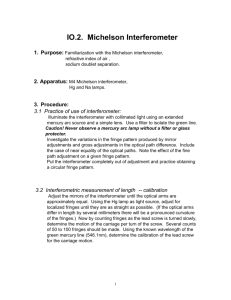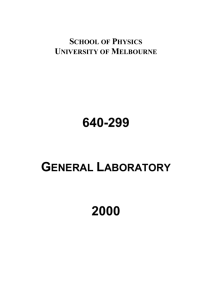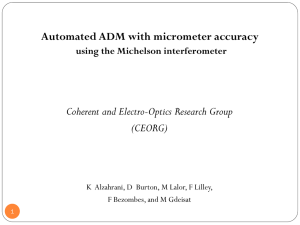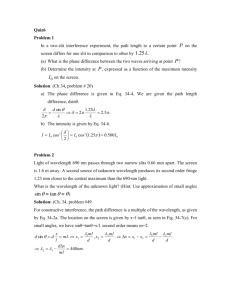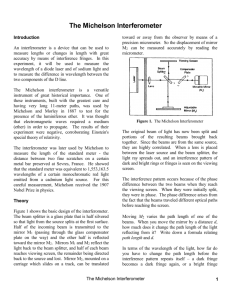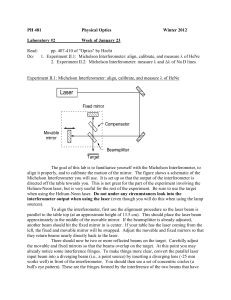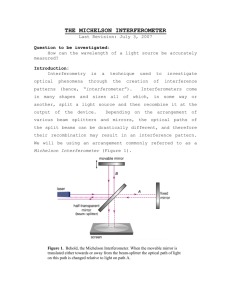Unit 1 Chapter 1: Michelson Interferometer Questions Problems
advertisement
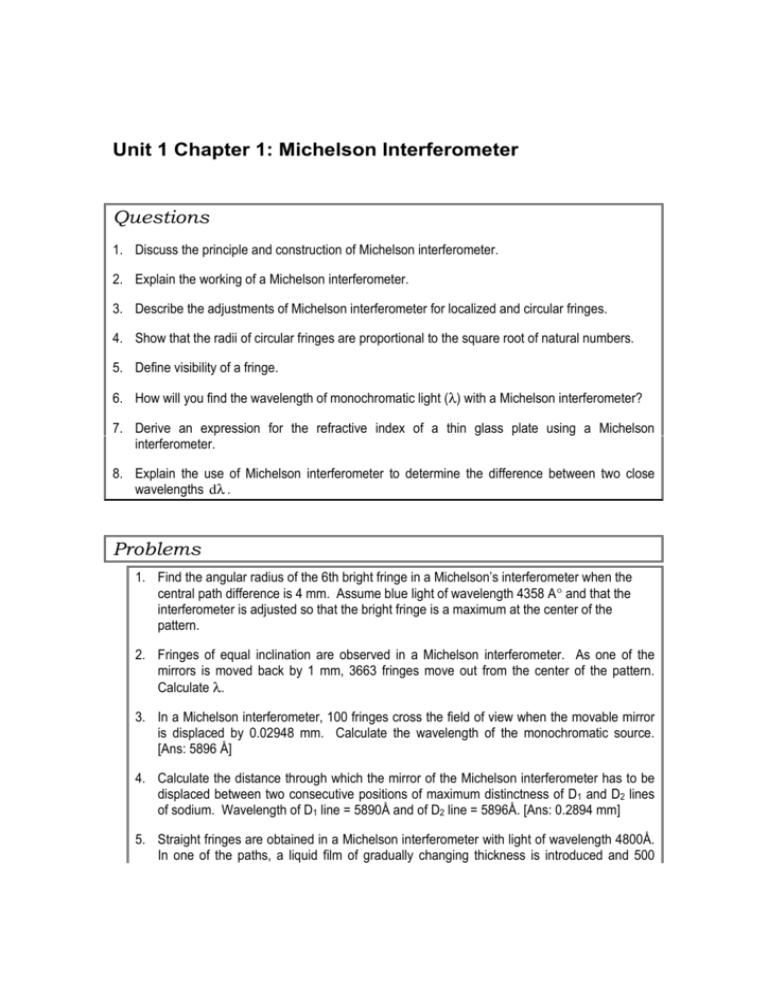
Unit 1 Chapter 1: Michelson Interferometer Questions 1. Discuss the principle and construction of Michelson interferometer. 2. Explain the working of a Michelson interferometer. 3. Describe the adjustments of Michelson interferometer for localized and circular fringes. 4. Show that the radii of circular fringes are proportional to the square root of natural numbers. 5. Define visibility of a fringe. 6. How will you find the wavelength of monochromatic light (λ) with a Michelson interferometer? 7. Derive an expression for the refractive index of a thin glass plate using a Michelson interferometer. 8. Explain the use of Michelson interferometer to determine the difference between two close wavelengths dλ . Problems 1. Find the angular radius of the 6th bright fringe in a Michelson’s interferometer when the central path difference is 4 mm. Assume blue light of wavelength 4358 A° and that the interferometer is adjusted so that the bright fringe is a maximum at the center of the pattern. 2. Fringes of equal inclination are observed in a Michelson interferometer. As one of the mirrors is moved back by 1 mm, 3663 fringes move out from the center of the pattern. Calculate λ. 3. In a Michelson interferometer, 100 fringes cross the field of view when the movable mirror is displaced by 0.02948 mm. Calculate the wavelength of the monochromatic source. [Ans: 5896 Å] 4. Calculate the distance through which the mirror of the Michelson interferometer has to be displaced between two consecutive positions of maximum distinctness of D1 and D2 lines of sodium. Wavelength of D1 line = 5890Å and of D2 line = 5896Å. [Ans: 0.2894 mm] 5. Straight fringes are obtained in a Michelson interferometer with light of wavelength 4800Å. In one of the paths, a liquid film of gradually changing thickness is introduced and 500 1100 C Chhaapptteerr O Onnee fringes cross the field of view. If the refractive index of the liquid is 1.40, calculate the change in the thickness of the film. 6. A thin plate of refractive index 1.5 displaces 10 fringes when it is introduced in one of the arms of the Michelson interferometer. Calculate the thickness of the plate. Given λ = 6000Å. [Ans: 6 x 10-3 mm] 7. In an experiment for determining the refractive index of air with a Michelson interferometer, a shift of 150 fringes is observed when all the air was removed from the tube. If the wavelength of the light used is 4000Å in air and the length of the tube is 20 cm, calculate the refractive index of air. 8. In an experiment with a Michelson interferometer, the distance through which the mirror is moved between two consecutive positions of maximum distinctness is 0.2945 mm. If the mean wavelength for the two components of the D lines of sodium light is 5893Å, deduce the difference between their wavelengths. [Ans: 6 Å] 9. Using red cadmium light, λ = 643.8nm, Michelson in his original experiment could still see interference fringes after he had moved one of the mirrors 25 cm away from the coincidence position. How many fringes did he count? [Ans: 776638] 10. How far must one of the mirrors of Michelson interferometer be moved for 400 fringes of light of wavelength 500 nm to cross the center of the field of view? [Ans: 0.01 cm] 11. Calculate the distance between two successive positions of the movable mirror of Michelson interferometer giving best fringes in the case of Na having lines of wavelengths 5893Å and 5896Å? [Ans: 0.058 cm] 12. After obtaining fringes in Michelson interferometer with white light, the white light is replaced by sodium light. If fringes are found to disappear when one mirror is moved through 0.289 mm, find the wavelength of the longer wavelength component when the shorter one has the value 5890 Å. 13. The distance traversed by the mirror in Michelson interferometer between two successive disappearances is 0.289 mm. Calculate the difference in wavelengths of D1 and D2 lines, λ = 5890Å. 14. If one arm of a Michelson interferometer contains a tube 2.5 cm long which is first evacuated and then slowly filled with air (μ = 1.0003), how many fringes will cross the center? Assume λ = 600nm. [Ans: 25] 15. If the contrast (visibility) in an interference pattern is 50% and if the receives 15 units of light, how much do the minima receive? [Ans: 5] 16. A transparent film of glass of refractive index 3/2 is introduced normally in the path of one of the interfering beams of a Michelson interferometer with light of λ = 4800Å. This causes 500 dark fringes to sweep across the field. Determine the thickness of the film. [Ans: 0.24 cm] C,JogaRao M Miicchheellssoonn IInntteerrffeerroom meetteerr 1111 17. A Michelson interferometer is set for white light straight fringes. When a mica sheet of thickness 0.005 cm is put in front of the fixed mirror, then in order to bring back the colored fringes to their original position, the movable mirror is moved by 0.0025 cm. Calculate the refractive index of mica. [Ans: 1.50] 18. When the movable mirror of the Michelson interferometer is shifted through 0.0589 mm, 200 fringes move across the field of view. Calculate the wavelength of the light used. [Ans: 5890 Å] 19. The wavelength of two components of D lines of sodium is 5890 Å and 5896 Å. By how much distance one of the mirrors of Michelson interferometer is moved so as to obtain consecutive position of distinctness. [Ans: 0.2894 mm] 20. In an experiment with Michelson interferometer, the distance traveled by the mirror for two successive positions of maximum distinctness was 0.2945 mm. If the mean wavelength for the two components of sodium D line is 5893 Å, calculate the difference between the two wavelengths. [Ans: 5.896 Å] 21. In an experiment with Michelson interferometer, the readings for maximum indistinctness were found to be 0.6939 mm and 0.9888 mm. If the mean wavelength for the two components of D lines were 5893Å, deduce the difference between the two wavelengths. 22. Two wavelengths λ1 = 5890Å and λ2 = 5896Å are emitted by a source of light. Interference fringes are observed in a Michelson interferometer with a certain arrangement when the paths of the interfering beams are exactly equal. How much will the path difference have to be increased so that a bright fringe for λ2 coincides with a dark fringe of λ1 ? 23. Circular fringes are observed in a Michelson interferometer illuminated with light of wavelength 5896 Å. If the path difference between the mirrors M1 and M2 is 0.3 cm, the central fringe is bright. Calculate the angular diameter of the 7th bright fringe. C.JogaRao
